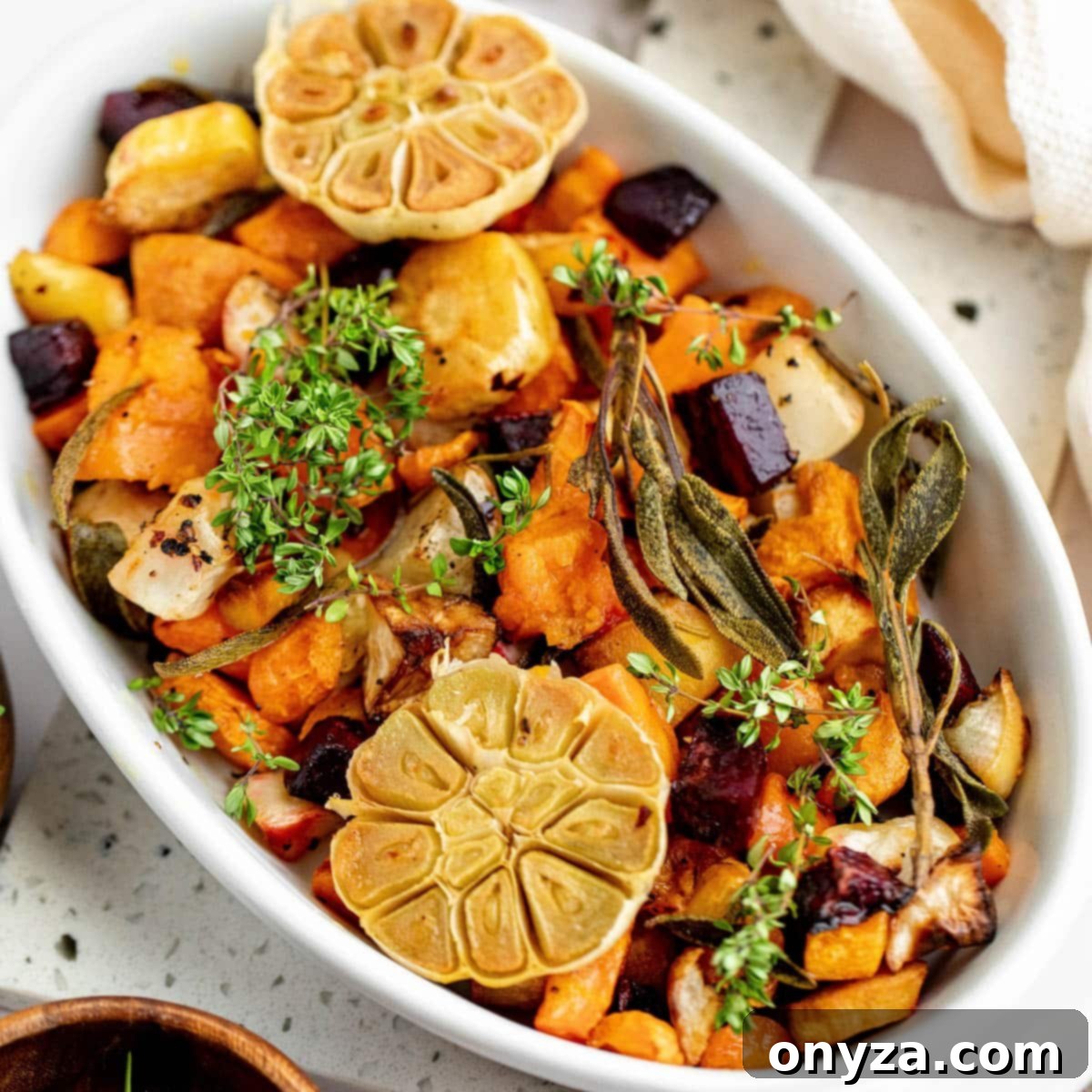Roasted Root Vegetables: Your Ultimate Guide to Perfectly Caramelized & Flavorful Sides
Experience the comforting delight of perfectly roasted root vegetables, a timeless side dish that effortlessly transforms humble ingredients into a culinary masterpiece. Ideal for hearty family meals, festive holiday gatherings, or as a vibrant addition to any seasonal spread, this simple roasting method coaxes out the natural sweetness of potatoes, carrots, beets, parsnips, and more, resulting in tender interiors and irresistibly caramelized edges. Discover how to create this versatile, nutritious, and incredibly flavorful dish that promises warmth and satisfaction with every bite.
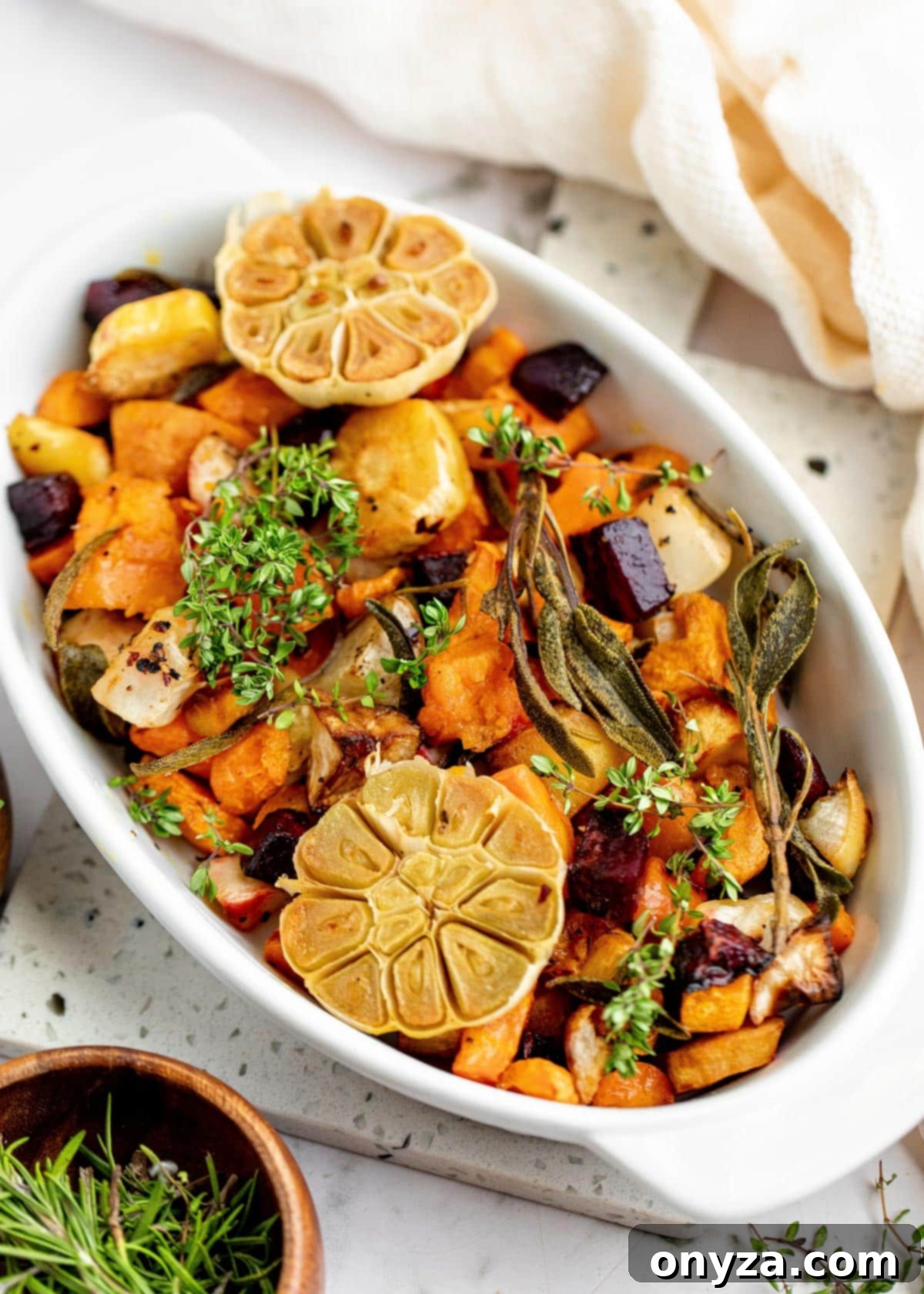
This article contains affiliate links. As an Amazon Associate, I may earn a commission from qualifying purchases made through these links, at no additional cost to you. All recommendations and opinions expressed are here are my own.
Why Roast Root Vegetables? A Seasonal Delight
Roasted root vegetables are more than just a side dish; they’re a celebration of seasonal bounty, bringing earthy flavors and vibrant colors to your table, especially during the cooler months. Their popularity stems from several compelling reasons that make them a go-to choice for home cooks and chefs alike.
- Unmatched Versatility: This recipe is incredibly adaptable. You can use almost any root vegetable you prefer, from classic carrots and potatoes to more adventurous parsnips, turnips, and beets. Mix and match to create a unique medley tailored to your taste, or use whatever is fresh and available at your local market. The possibilities are endless, allowing for new flavor experiences with each preparation.
- Effortless Preparation: One of the greatest appeals of roasted root vegetables is their simplicity. The process requires minimal hands-on time – essentially just chopping, tossing with oil and seasonings, and letting the oven do the heavy lifting. This makes it an ideal dish for busy weeknights or when you’re preparing a larger holiday meal with multiple components.
- Irresistible Flavor and Texture: Roasting is a magical cooking method. The dry, high heat of the oven not only softens the vegetables to a delightful tenderness but also caramelizes their natural sugars, creating a sweet, nutty, and deeply savory flavor profile. The edges become beautifully browned and slightly crispy, providing a textural contrast that is simply addictive.
- Nutrient-Rich Goodness: Root vegetables are nutritional powerhouses. They are packed with essential vitamins (like Vitamin A and C), minerals (such as potassium and iron), and dietary fiber, all vital for maintaining a healthy diet. Enjoying them roasted is a delicious way to boost your intake of these beneficial compounds, making this dish both comforting and wholesome.
- Perfect for Meal Prepping: Roasted root vegetables store and reheat exceptionally well, making them an excellent choice for meal prepping. Prepare a large batch at the beginning of the week, and you’ll have a nutritious and flavorful component ready to add to salads, grains, or as a quick side for other meals throughout the week.
Craving roasted veggies but short on time? Explore our recipe for Air Fryer Root Vegetables, featuring a delectable maple glaze for a quicker, equally delicious option!
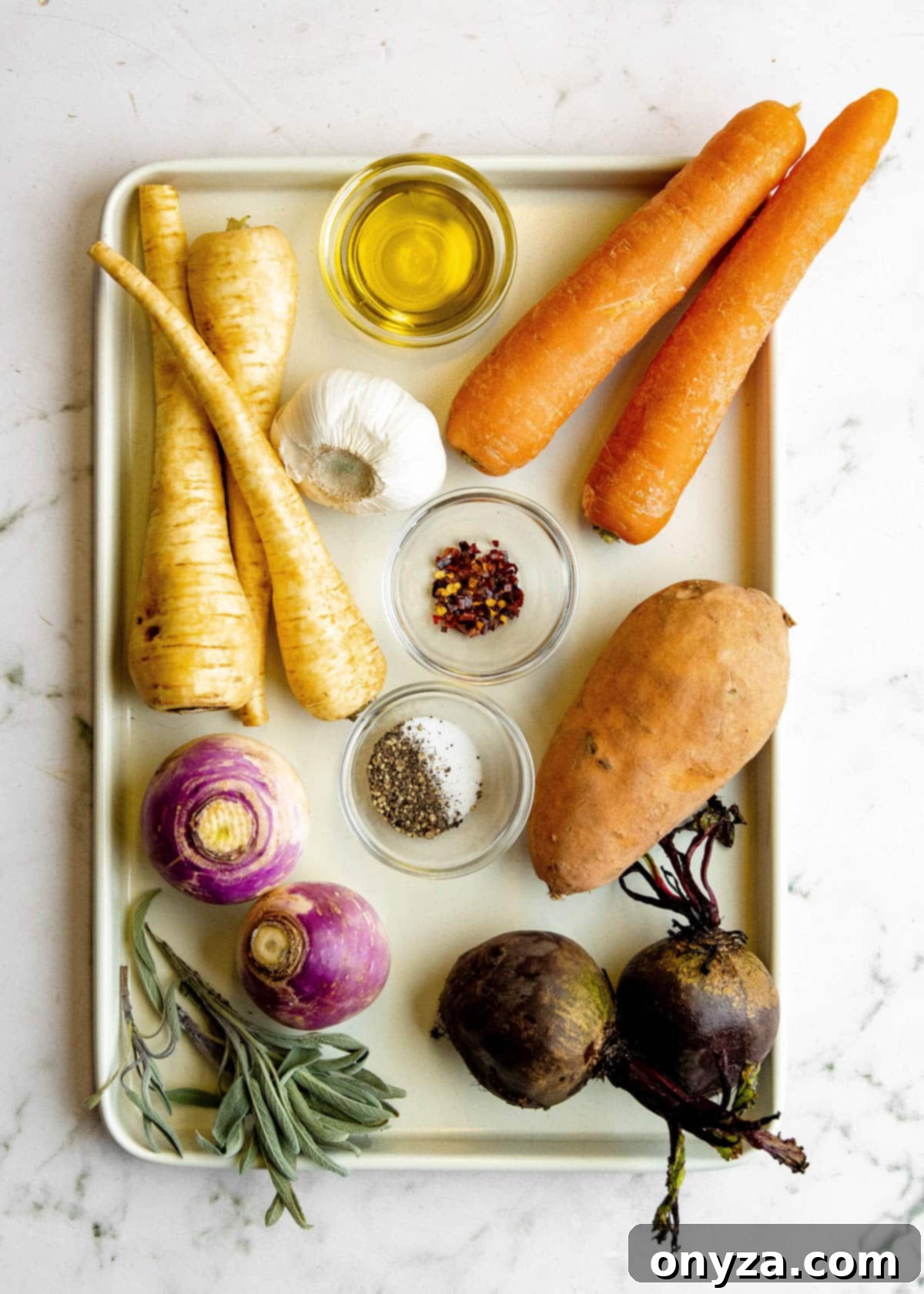
Essential Ingredients for Perfectly Roasted Root Vegetables
Crafting the best roasted root vegetables starts with selecting quality ingredients. Here’s what you’ll need to create this comforting side dish:
- Assorted Root Vegetables: The heart of this recipe! You have complete freedom to choose your favorites. For a visually stunning and flavorful medley, consider a mix of carrots (rainbow carrots add beautiful color), parsnips, turnips, vibrant beets, hearty sweet potatoes, and a head of garlic. Other excellent choices include red onions, classic white potatoes (Yukon Gold or Russet), rutabagas, and celeriac. Always select firm, fresh, and unblemished vegetables for the best texture and taste.
- Olive Oil: A good quality olive oil is crucial for achieving that desirable caramelization and flavor. We recommend using regular olive oil over extra virgin for roasting due to its higher smoke point, which prevents burning at high temperatures, and its milder flavor profile that won’t overpower the vegetables. Filippo Berio Olive Oil is a consistent pantry staple for its reliability in both sautéing and roasting.
- Fresh Herbs: Herbs infuse the vegetables with an aromatic depth that elevates the entire dish. Incorporate a few sprigs of robust fresh herbs like sage, rosemary, and/or thyme directly onto the baking sheet during roasting. These herbs will crisp up beautifully in the oven and impart their fragrance. For a final touch, a scattering of fresh herbs after roasting adds a bright pop of color and freshness.
- Salt and Pepper: These foundational seasonings enhance the natural flavors of the vegetables. We typically use Diamond Crystal Kosher Salt or a fine sea salt, along with freshly ground black pepper (preferably a medium to coarse grind for noticeable flavor). For those who enjoy a subtle kick, a few small pinches of crushed red pepper flakes can be added during seasoning to introduce a pleasant warmth.
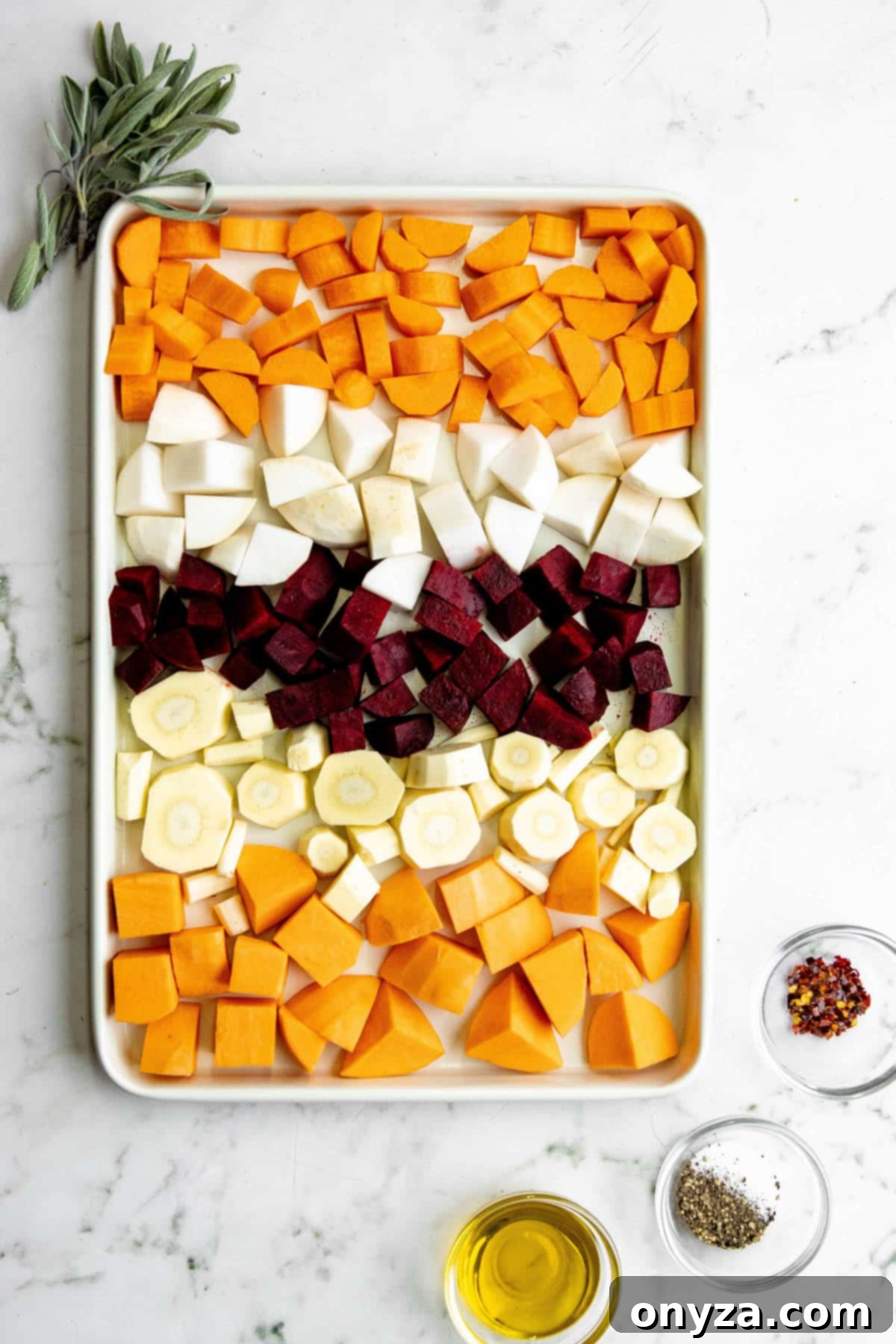
Preparing Your Root Vegetables for Roasting
Cleaning and Peeling Tips
Proper preparation is key to delicious roasted root vegetables. Begin by thoroughly cleaning all your vegetables. Use a stiff scrubbing brush under cool to lukewarm running water to remove any dirt or soil. A comfortable and effective brush, such as the Full Circle Ring Brush, with its bamboo handle and natural bristles, makes this task easy.
The decision to peel your root vegetables often comes down to personal preference and the specific type of vegetable. Many root vegetable skins are edible and contain valuable nutrients, fiber, and antioxidants, so leaving them on can be a healthier choice. However, some skins are tough or fibrous and are best removed for optimal texture.
Generally, I tend to peel most of my root vegetables for roasting to ensure a consistently smooth texture. The exceptions are thin-skinned varieties like carrots, waxy potatoes (e.g., Yukon Gold), and young parsnips, which I frequently roast with their skins on. Whole garlic bulbs are always roasted unpeeled, as their skins protect the cloves, allowing them to soften and sweeten beautifully.
| Root Vegetable | Peel/Optional* |
|---|---|
| Carrots | Optional |
| Sweet Potatoes and Yams | Peel |
| Waxy Potatoes (such as Yukon Gold or Red Bliss) | Optional |
| Floury Potatoes (such as Russet) | Peel |
| Young, Small Parsnips | Optional |
| Larger Parsnips with Thicker Skins | Peel |
| Turnips | Peel |
| Rutabaga | Peel |
| Celery Root (Celeriac) | Peel |
| Beets | Optional |
| Onions | Peel |
*This chart provides a general guideline. As a good rule of thumb, if the skin of the root vegetable is thin and delicate, you can choose to roast it with the skin on or peel it. However, thicker, tougher, or more leathery skins should typically be peeled for the best eating experience.
While beet skins are technically edible, I prefer to peel them for a more refined texture in the final dish. Beets can notoriously stain hands and surfaces, so it’s wise to wear latex or disposable gloves while peeling and handling them. To minimize cleanup, I recommend prepping beets last among your assortment of vegetables.
Looking for more detailed guidance on handling beets? Discover clever tricks to make peeling beets a breeze in the “Raw Beets” section of this helpful article from Real Simple.
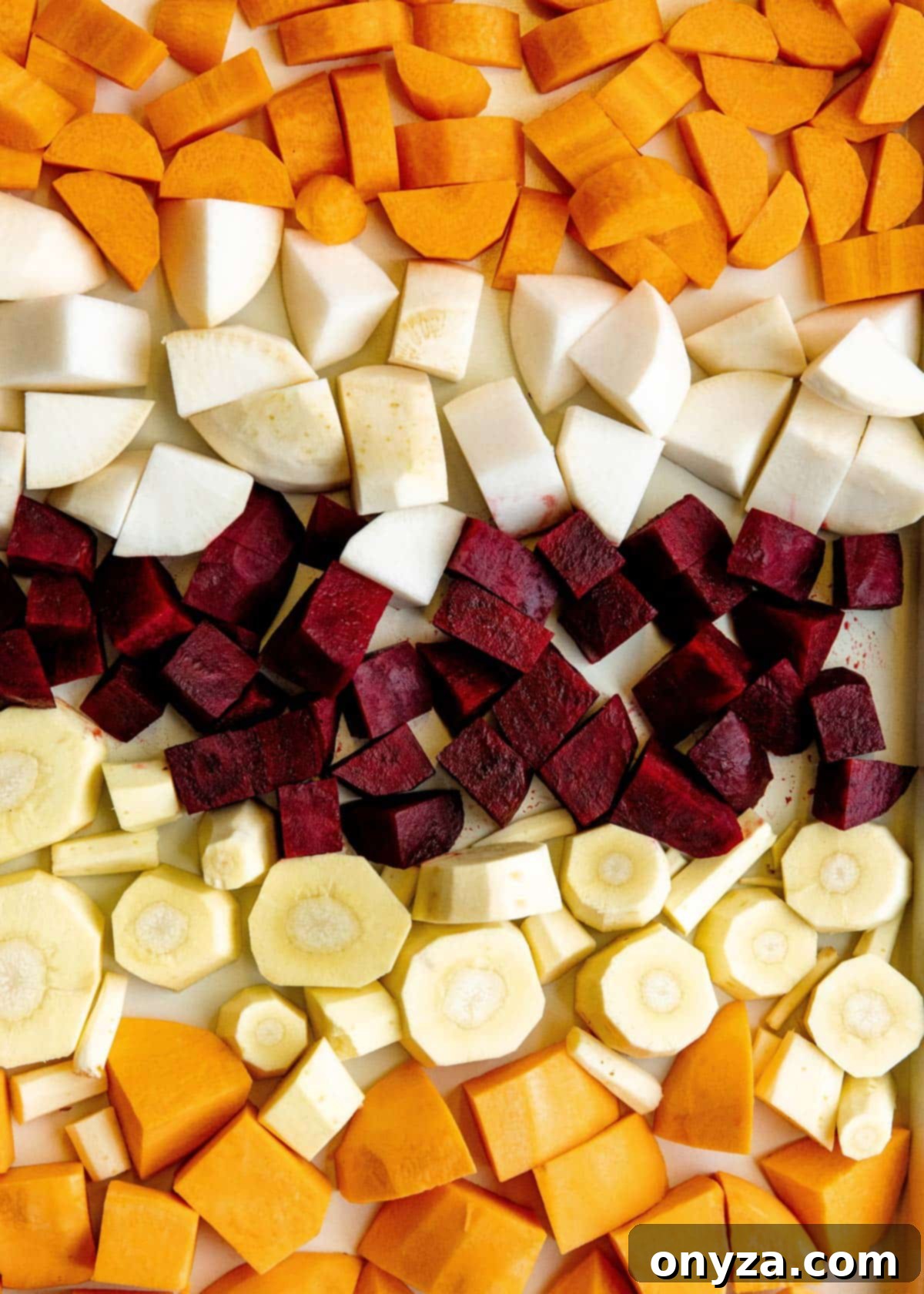
Cutting Root Vegetables for Optimal Roasting
The way you cut your root vegetables significantly impacts their cooking time and overall texture. Aim to cut all vegetables into pieces that are roughly 1 to 1-1/2 inches in size. While a rustic chop is perfectly acceptable, striving for similarly sized cuts is crucial to ensure that all vegetables cook evenly and finish roasting at the same time, preventing some pieces from burning while others remain undercooked.
For tubular-shaped root vegetables like carrots and parsnips, you can cut them into rounds, half-moons, or even short sticks, depending on their thickness. It’s important to cut off and discard (or save for making vegetable stock) any very thin tips of carrots or parsnips. These smaller pieces will cook much faster than the larger cuts and are prone to burning before the rest of the vegetables are tender.
Rounder vegetables, such as potatoes, turnips, and beets, are best sliced into uniform cubes or wedges. If you’re roasting garlic along with your other vegetables, simply cut the entire bulb in half crosswise, exposing the cloves without peeling them individually. This allows the garlic to roast beautifully, becoming sweet and mellow.
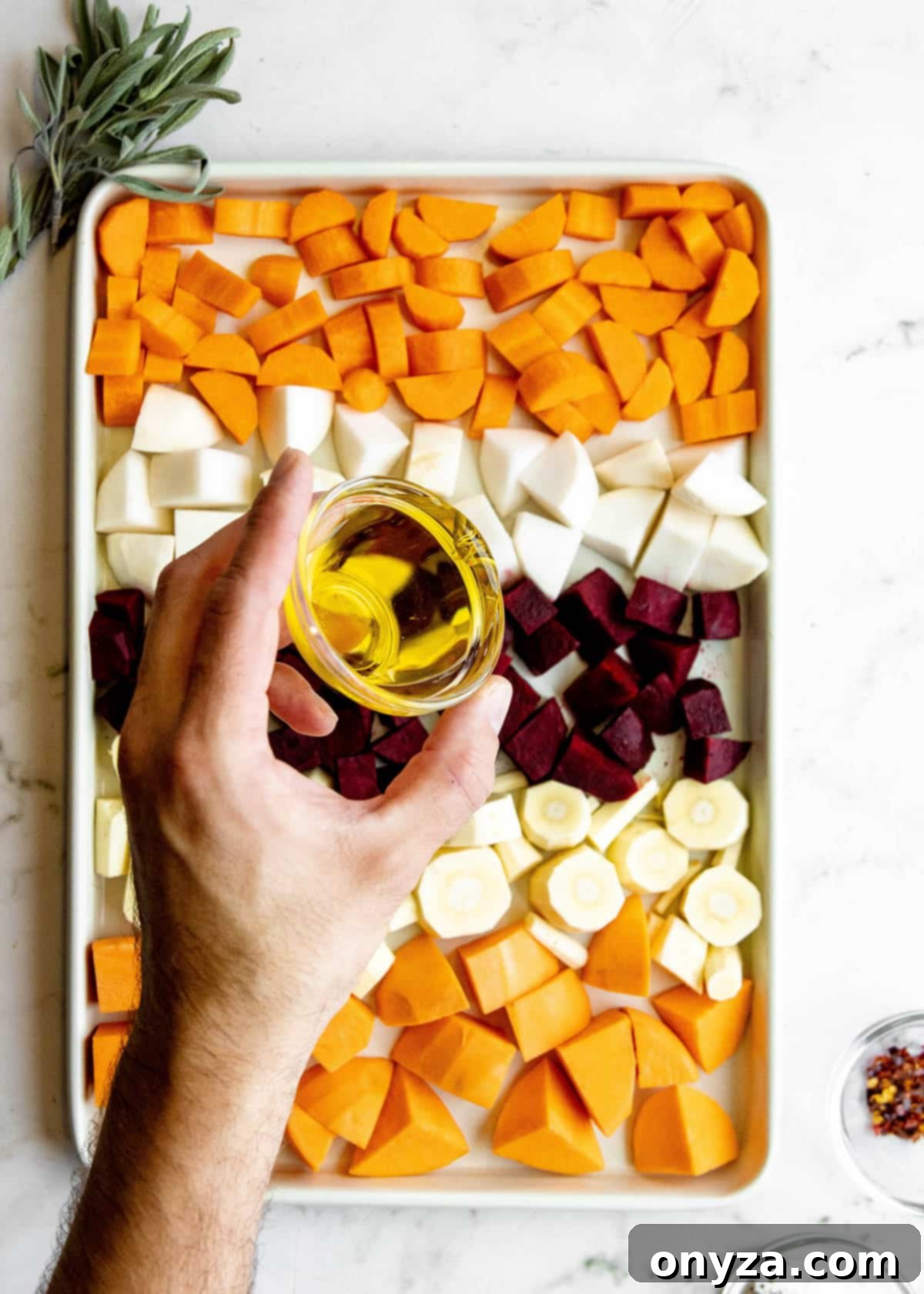
The Art of Roasting Root Vegetables: Step-by-Step
Achieving perfectly caramelized and tender roasted root vegetables is a straightforward process when you follow these simple steps:
- Preheat Your Oven: Begin by preheating your oven to 425 degrees F (220 degrees C) and position the oven rack in the middle. This high temperature is essential for achieving the beautiful browning and caramelization that makes roasted vegetables so delicious.
- Prepare Your Baking Sheet: For the easiest cleanup, line a rimmed half sheet pan with aluminum foil or parchment paper. This also helps prevent sticking and promotes better browning.
- Arrange the Vegetables: Spread your prepped and cut root vegetables in a single layer on the prepared baking sheet. It’s crucial not to overcrowd the pan. If the vegetables are packed too tightly, they will steam instead of roast, leading to soft, rather than crispy, results. If you’re preparing a large batch, or if your pan appears too full, use two baking sheets. This ensures proper air circulation, which is vital for caramelization. If you’re including garlic, hold off on adding it for just a moment.
- Season Generously: Drizzle the vegetables with 3 tablespoons of regular olive oil, ensuring all pieces are lightly coated. Season them thoroughly with salt and freshly ground black pepper. For a 3-pound batch of vegetables, I typically use about 1 to 1-1/2 teaspoons of kosher or fine sea salt and 1/2 teaspoon of medium- to coarse-grind black pepper. If you desire a hint of spice, now is the time to toss in a few pinches of red pepper flakes along with the salt and pepper.
- Add Garlic and Herbs: Now, nestle the halved garlic bulbs (if using) among the seasoned vegetables on the baking sheet. Drizzle each garlic half with a little of the remaining 1 tablespoon of olive oil and season with a small pinch of salt and pepper. Finally, lay a few sprigs of fresh sage, rosemary, or thyme over the vegetables. These herbs will crisp up beautifully in the oven and impart a wonderful aroma and flavor throughout the dish.
- Roast to Perfection: Place the baking sheet in the preheated oven and roast for 40-60 minutes. Halfway through the cooking time (around 20-30 minutes), gently stir the vegetables to ensure even cooking and browning on all sides. If at any point the vegetables appear too dry, drizzle them with a little more olive oil to prevent sticking and promote continued caramelization. The vegetables are ready when they are fork-tender in the center and beautifully browned and caramelized around the edges, exuding a delicious, sweet, and earthy aroma.

Serving Your Roasted Root Vegetables
Once your root vegetables are perfectly roasted, they are ready to shine on your table. Before serving, taste and adjust seasonings as needed, adding a little more salt or pepper if desired. For a fresh pop of color and enhanced aroma, I love to garnish the serving platter with additional fresh herbs such as fresh thyme, rosemary sprigs, or finely chopped parsley. This simple touch elevates the presentation and adds another layer of flavor.
Roasted root vegetables are incredibly versatile and make a simple yet sophisticated side dish for a wide array of fall and winter meals. They pair wonderfully with robust proteins. We frequently enjoy them alongside succulent roasted chicken, tender pork loin, or savory pork chops for a truly cozy and satisfying dinner. They are also a fantastic accompaniment to lighter options, such as our Pecan-Crusted Salmon, where their earthiness balances the richness of the fish.
Beyond everyday meals, this recipe is a magnificent addition to any holiday dinner spread. Their vibrant colors and comforting flavors add a festive touch to the table. They are particularly delicious when served alongside a traditional herb-roasted turkey breast for Thanksgiving or Christmas, complementing the rich flavors of the holiday feast beautifully.
Eager to expand your repertoire of delightful roasted vegetable recipes? You’ll love our easy recipes for Roasted Cabbage Wedges and flavorful Roasted Radishes with Tarragon Vinaigrette!

Storing, Reheating, and Creative Leftover Ideas
One of the many advantages of roasted root vegetables is how well they store and reheat, making them an excellent candidate for make-ahead meals or enjoying as delicious leftovers. Once cooled to room temperature, transfer them to an airtight container and store them in the refrigerator for 3-4 days.
Best Methods for Reheating Roasted Root Vegetables
You have several options for reheating, depending on your preference for texture and convenience:
- To reheat in the oven: This is my preferred method for maintaining optimal texture. Spread the leftover vegetables in a single layer on a rimmed baking sheet. Bake at 350 degrees F (175 degrees C) for approximately 10-15 minutes, or until they are thoroughly heated through and have regained some of their crispness.
- To reheat in the air fryer: For a quick and crispy result, arrange the root vegetables in a single layer in your air fryer basket. Cook at 380 degrees F (195 degrees C) for 2-3 minutes, shaking the basket halfway, until they are hot and re-crisped. Note that air fryer times can vary slightly by model.
- To reheat in a skillet: Heat about a tablespoon of olive oil or butter in a nonstick skillet over medium-high heat. Add the roasted vegetables in a single layer and sauté, stirring occasionally, until they are heated through and the edges have crisped up again.
- To reheat in the microwave: While convenient, the microwave is not ideal for re-crisping roasted vegetables. Place the veggies on a microwave-safe plate and cover with a plastic microwave cover or damp paper towel. Reheat in 20 to 30-second intervals until warmed through. This method is best for speed, but the vegetables may lose some of their roasted texture.
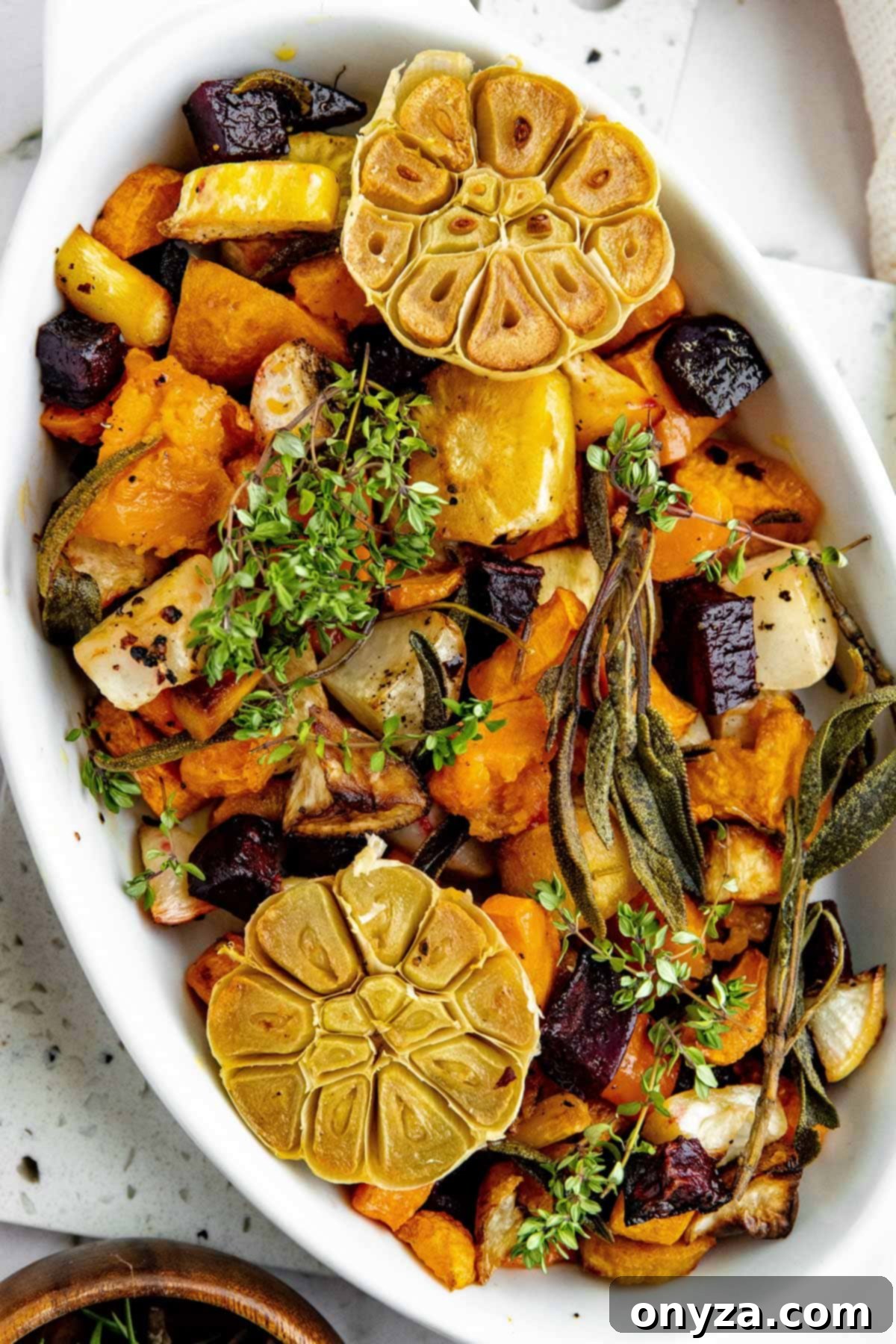
Creative Ways to Use Leftover Roasted Root Vegetables
Don’t let any delicious leftovers go to waste! Roasted root vegetables can be creatively repurposed into new and exciting dishes:
- Elevate Your Salads: Leftover roasted root vegetables add a hearty, flavorful, and colorful dimension to your fall and winter salads. Combine them with crisp leafy greens, crunchy nuts, crumbled goat cheese or feta, and your favorite dressing. For a delicious pairing, try our Maple-Dijon Vinaigrette. You can also substitute roasted beets or sweet potatoes for the butternut squash in our vibrant Harvest Cobb Salad for a seasonal twist.
- Transform into a Warming Soup: Puree leftover roasted root vegetables to create a comforting and nutritious soup. Simply blend them with enough vegetable or chicken broth to achieve your desired consistency. Season to taste with herbs and spices, then serve warm with a dollop of crème fraîche, a swirl of heavy cream, or a sprinkle of fresh croutons for a gourmet touch.
- As a Flavorful Pizza or Flatbread Topping: Give your autumnal pizzas or flatbreads a unique and delicious topping. Spread your favorite pizza dough with a light sauce, scatter mozzarella cheese, then arrange the roasted root vegetables on top, perhaps with dollops of creamy ricotta. Bake until the crust is golden and the cheeses are bubbly and melted. A final drizzle of balsamic glaze adds a wonderful sweet-tangy finish.
- For a Hearty Breakfast Hash: Start your day with a satisfying breakfast hash. Cook a few strips of bacon in a large skillet until crisp, then remove and crumble. Leave about 1 tablespoon of bacon fat in the pan, then add your leftover roasted root vegetables. Cook over medium-high heat, stirring occasionally, until they are heated through and nicely crisped on the edges. Stir the crumbled bacon back into the hash. Serve immediately with a perfectly poached, fried, or sunny-side-up egg for a truly wholesome and delicious breakfast.
More Seasonal Fall & Winter Side Dishes to Explore
If you enjoyed this recipe, expand your seasonal cooking with these other delightful side dishes:
- Brown Butter Whipped Sweet Potatoes: A rich and creamy twist on a classic.
- Roasted Brussels Sprouts with Pomegranate Glaze: A vibrant and tangy addition to any meal.
CRAVING MORE DELICIOUS RECIPES? Be sure to subscribe to my newsletter and connect with me on Facebook, Pinterest, and Instagram for the latest culinary inspirations and news.

Roasted Root Vegetables
by Amanda Biddle
Classic Roasted Root Vegetables are a simple, hearty dish that brings out the natural flavors of carrots, parsnips, turnips, sweet potatoes, and more. The perfect side for any fall or winter meal.
Cook Time: 45 minutes
Total Time: 1 hour
Servings: 6 servings
Ingredients
- 3 pounds assorted root vegetables (such as carrots, beets, turnips, parsnips, and sweet potatoes)
- 1 whole head of garlic (optional)
- 4 tablespoons regular olive oil, plus additional if needed
- 3-4 sprigs fresh sage leaves (or another fresh herb of your choice, such as thyme or rosemary)
- Kosher or sea salt and freshly ground black pepper
- Chopped fresh herbs, for garnish
Instructions
- Preheat oven to 425 degrees F (220 degrees C) with the rack in the middle position. Line a half-sheet pan with foil for easy cleanup.
- Peel root vegetables (see notes below for guidance) and cut into roughly 1- to 1-1/2 inch chunks or slices. Cut and discard any very thin tips from tubular vegetables, such as carrots and parsnips, to prevent burning. If using, cut the whole head of garlic in half crosswise, without peeling.
- Add the cut vegetables (except for the garlic) to the large baking sheet. Drizzle with 3 tablespoons of olive oil and toss to coat evenly. Season generously with salt and pepper. (I typically use 1 to 1-1/2 teaspoons of salt and 1/2 teaspoon medium- to coarse-grind black pepper for 3 pounds of vegetables.)
- Nestle the two garlic halves into the root vegetables and drizzle each with some of the remaining 1 tablespoon of olive oil. Season the garlic with a pinch of salt and pepper. Place the sprigs of fresh sage (or other chosen herbs) on top of the root vegetables.
- Roast for 40-60 minutes, stirring the vegetables halfway through the cooking process. Continue roasting until the vegetables are tender in the center and beautifully caramelized and browned around the edges.
- To serve, taste and season with additional salt and pepper if desired. Garnish the serving platter with chopped fresh herbs (such as fresh thyme, rosemary, or parsley) for a fresh burst of color and flavor. Serve hot or warm. Store any leftovers in an airtight container in the refrigerator for 3-4 days.
Notes
*Peeling some varieties of root vegetables is optional. In general, vegetables with thick, tough peels (such as sweet potatoes) should be peeled before roasting. Thinner-skinned varieties, such as carrots, can be roasted unpeeled if you prefer. See the section “Preparing Your Root Vegetables” in the article above for more detailed information and a handy guideline chart.
Be sure not to overcrowd the root vegetables on the baking sheet. If they’re tightly packed, they will steam rather than caramelizing, leading to a softer texture. If needed, divide the vegetables between two baking sheets and roast them in the upper and lower thirds of the oven, rotating the pans halfway through to ensure even cooking.
Flavor Variation: To introduce a delightful pop of heat to your roasted vegetables, season them with about 1/2 teaspoon of crushed red pepper flakes (adjust quantity to your taste preference) at the same time you add the salt and pepper before roasting.
Nutrition Estimate
Serving: 0.1666 recipe | Calories: 266kcal | Carbohydrates: 43g | Protein: 3g | Fat: 11g | Saturated Fat: 2g | Polyunsaturated Fat: 1g | Monounsaturated Fat: 7g | Sodium: 414mg | Potassium: 899mg | Fiber: 13g | Sugar: 11g | Vitamin A: 295IU | Vitamin C: 40mg | Calcium: 152mg | Iron: 3mg
Nutrition information is automatically calculated and should only be used as an approximation. Individual values may vary based on ingredients and preparation.
About Our Recipes
Please note that our recipes have been developed using the US Customary measurement system and have not been specifically tested for high altitude/elevation cooking and baking conditions. Adjustments may be necessary depending on your location.
Enjoyed this recipe? Please consider rating it and leaving a comment below! Your feedback helps us share more delicious dishes.
